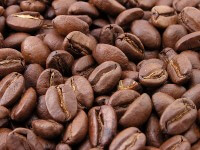 I don’t know much about coffee other than I prefer dark roast over light, although I’m a bit wary of the higher caffeine in a strong, dark roast. Except caffeine is not determined by roasting style—it’s decided by the ratio of coffee to water. You might’ve known that—I didn’t. (I also hear that to best appreciate coffee, try slurping it.) In any event, Katy McLaughlin reports in the Wall Street Journal that light roasts are becoming the new thing:
I don’t know much about coffee other than I prefer dark roast over light, although I’m a bit wary of the higher caffeine in a strong, dark roast. Except caffeine is not determined by roasting style—it’s decided by the ratio of coffee to water. You might’ve known that—I didn’t. (I also hear that to best appreciate coffee, try slurping it.) In any event, Katy McLaughlin reports in the Wall Street Journal that light roasts are becoming the new thing:
Coffee companies are doing well as demand grows world-wide, though the economic downturn slowed expansion in the U.S., analysts say. This drove firms to conjure up additional products—including light roasts—to draw in new customers and sell more to their regulars.
It’s a dramatic turn for the specialty coffee industry, which began expanding rapidly 20 years ago. This new coffee differed from what Americans were used to with its strong, bold, deep taste—partly the result of dark-roasted beans. Many coffee snobs say they can only drink the dark brews at Starbucks or Peet’s, and that anything else tastes like dishwater.
U.S. coffee drinkers may tend to think of dark roast as European and sophisticated. However, light-roasted coffee, brewed strong, is the norm in Northern Europe, including Germany and Scandinavia. Many high-end roasters today are working to convince customers that light roasting is the best way to coax the delicate, nuanced flavors out of high quality beans.
UPDATE 4:07 p.m.: Reader Adam J. White brings to our attention an item from weeklyroast.com explaining that light roast technically has more caffeine than dark roast coffee:
The quick answer is that for the most part, lighter roasts actually have more caffeine than darker roasts. When coffee beans are roasted, the beans undergo a series of physical changes including growing in size, becoming lighter in weight but also burning off some caffeine. The longer the beans are roasted (the darker the beans), in general, the less caffeine they will have solely due to them having more and more caffeine being burned off.
Now, it does get a bit more complicated than that. I mentioned that the longer coffee beans are roasted, the lighter they become (weight loss) so a pound of lightly roasted coffee could potentially have about the same caffeine content as a pound of dark roast (for example, a french roast coffee), simply because it would take more beans of a dark roast (going by weight) to make a pound. But, in general, taking 2 pounds of the exact same coffee – roasting one pound lightly and one dark – and not adding more beans to the darker roast to account for the weight loss due to roasting longer – the lighter roast will usually have more caffeine.
Thanks, Adam. Now get back to work!